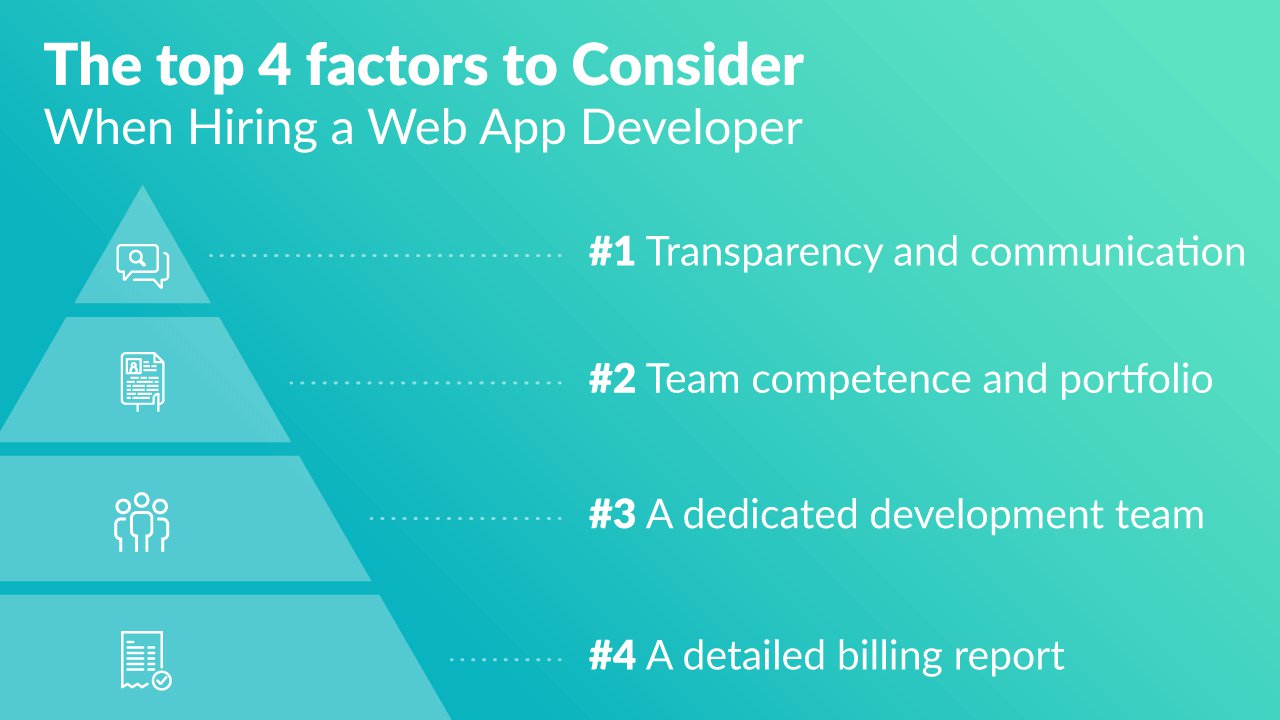
Choosing the company to develop your web application can be a daunting task. After all, you probably have the perfect vision of your app in your head, clear as day. Who can you trust to make this vision a reality? What factors should you consider when selecting the perfect web application vendor?
In this post we will show you the results of a survey carried out among our customers, including their answer to the following question:
What did you look for when choosing a web application vendor?
The answers provided by our clients were diverse but we have managed to narrow them down to four top factors that were the most crucial in their decision. Here they are:

Let’s dismantle these results and try to uncover why they drove our clients’ decision.
Transparency and communication took the top spot in our survey, and for good reason. Nothing is more discouraging than the lack of information from the vendor about what is happening with the project and at what stage it is. There are times when the only sign of transparency is a haphazard task list in some random project management system, with no information on what parts of the project are complete and no indication of any problematic tasks that may have arisen.
But perhaps the most blatant symptom of flawed communication is a weekly email report stating: “Everything is proceeding according to plan. We do not have any questions. Everything is clear.” Unfortunately, nothing could be worse.
What kind of transparency and communication should you look for in your vendor, then? Consider a company that uses the Scrum framework. Scrum employs daily ‘Stand-ups’, short meetings which help the team stay up to date on development progress. With a well-informed team, Scrum also allows the client to always have access to information on progress, potential problems and what to expect after each time-limited development Sprint.
Another indicator of transparency is the use of tracking software such as Jira to manage “user stories” and contain the product’s backlog along with information on the current Sprint. Developers using Jira update the tasks on a regular basis and send current status notifications to the product owner or any other responsible party on the client side.
Another way to keep the client up to date is the so-called demo where the team presents the latest version of the application. The goal is very simple: they want to be proud of what they have done and get the client’s acceptance. Using such methods the nervous client can verify the product vision after just two weeks.
At first glance, many would place the developer’s competence as the most important factor in the selection process. It is true that a strong, talented team can tackle even the most difficult tasks. However, competence placed second in our survey; probably because even the most talented programmer is not able to deliver a project 100% tailored to the needs of the client without knowing how to work in a group and how to properly communicate.
Without a clear and complete image of the client’s web app, an image brought into focus through communication, the developer will only be realizing their own vision of what the client ‘probably’ wants.
Therefore, the perfect web application vendor would be one that combines soft communication skills and hard technical skills. Only with these two sets of skills working in unison can the client rest easy that their project is in good hands.
Imagine a situation where 100 developers are sitting together in an open space. At first glance: great! However, communication is crucial in each project. How can you discuss ongoing issues when everyone else is listening? You cannot focus on anything, because everyone around you is “negotiating” and “agreeing” on something.
Isn’t it better to have your own dedicated team which sits in one room with no one to bother them? This lets the team focus on the results of their project instead of the problems of a hundred people around them. You can arrange a meeting with the team at any time, without looking for the space and peace and quiet to have a word, because they are all available in a single room.
Now imagine another situation: the Product Owner is in one city, two developers are working remotely from home, another two are in a different office in another city, and yet another contributes as a freelancer only when he has the time. That’s right, mission impossible!
Although one should not put all the available developers together in one space, they also cannot be thrown around the four corners of the world. This is why having a dedicated development team with its own development space is so beneficial, and sought after by clients. The consistency of the team has a large impact on its success, improving communication and helping the team integrate faster.
Let’s say you have decided on a web application vendor and work seems to be progressing smoothly. Even in such a case, the issue of billing may still arise, as indicated by the fourth most common answer in our survey.
Can you imagine having no idea what a programmer is doing? How can you be certain that he is not working on any other project, claiming that he’s working for you?
Are you sure he hasn’t spent half of his time playing games?
Some might call such thinking worthy of a regime – nothing could be further from the truth. There is a place for entertainment during the development process, even during work hours. But no one should pay for that time, and certainly not the client.
A detailed billing report is the ideal solution. The client receives a printout of the hours worked by each developer and can see how long a task took. Any suspicious periods of ‘slow development’ are immediately visible on the report. This is another way to show the transparency which our clients indicated as a top decision factor.
Obviously, outsourcing is a potential solution for your software development needs. But where should you look to choose the best web app vendor?
One possibility is nearshoring - the idea of finding an outsourcing software company that is not only reliable, but also geographically close to you, lowering costs and facilitating communication.
In fact, we’ve compiled a step-by-step guide to nearshoring for executives - grab it for free here.
Aside from cost, what other factors would you consider when choosing a vendor? Make sure to drop us a comment and share this post with anyone looking to outsource their web application development.